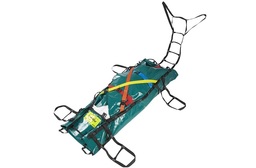Fire safety legislation places the onus on the ‘responsible person’ – a person who has some level of control of premises, to assess, reduce and manage fire risk. This include ensuring that everyone who may be on the premises has a means of escape. However, some organisations believe that the evacuation of disabled people is the responsibility of the fire and rescue service. Government guidance clearly states that a premises emergency plan “should not rely on fire and rescue service involvement”.
When creating an emergency fire action plan it is important to think about everyone who is likely to be in the building and will need evacuating. The safe egress and evacuation of disabled people requires careful consideration and attention because not everyone with a disability will require help. There may be people with ‘hidden impairments’, a heart condition or epilepsy, for example, that may require assistance in an emergency evacuation. Deaf people may not be able to hear the fire alarm, people with visual impairment may not be able to read fire exit signs clearly and people with a mental health issue may react in an unusual way.
Personal Emergency Evacuation Plans
In any organisation, it is the responsibility of the ‘responsible person’ to plan for the evacuation of disabled people using their premises. A Personal Emergency Evacuation Plan (PEEP) is a tailor made escape plan for individuals who may not be able to reach an ultimate place of safety unaided in the event of an emergency.
PEEPs may be required for people with:
- Mobility impairments
- Sight impairments
- Hearing impairments
- Cognitive impairments
Temporary PEEP’s may be required for:
- Short term injuries (i.e. broken leg)
- Temporary medical conditions
- Those in the later stages of pregnancy
Emergency Refuges
Refuges, often located in stairwells, are intended as an area to protect evacuees for sufficient time as to enable staff to assist wheelchair users or other mobility-impaired people to safety. These areas should be clearly marked and be at least 900mm x 1400mm in size.
There should be a two-way communications system between the refuge and another area – such as the building reception, if constantly manned, or an outside monitoring service – that can be answered at all times. If necessary, the refuge should contain written safety instructions and a description of the refuge location so that anyone using it can pass on details of their location to the person receiving the call.
A refuge is merely the first stage in the evacuation procedure for disabled person, further plans and procedures should be in place to ensure that persons are able to be evacuated from the refuge under safe and controlled conditions.
Suitable evacuation aids should be easily identifiable, accessible and ready for immediate use. Such aids will often be found in these refuge areas.
Emergency Evacuation Aids
Evacuation chairs
Evacuation chairs make moving people downstairs, and in some cases upstairs, relatively easy. They come in different shapes and sizes with different functions and capabilities. Using an evacuation chair minimises the risk of manual handling and associated injuries, which could occur if the person were to be physically carried out of the building.
Mattress sheets and slip mats
Evacuation mats and sheets offer a simpler alternative to chairs. These can be used for people with mobility impairment and people who are bed bound. Evacuation mats or pads, look like a thin mattress with buckles which the person being evacuated is securely strapped to whilst moved to safety. Evacuation sheets, mainly used in hospitals and care homes, are permanently attached to the underside of the mattress and allow the user to be evacuated securely on the mattress. Both Evacuation mats and sheets can be used through corridor as well as on stairs. It is essential to check the size of the doors and corridors on the escape route to make sure the mat or sheet will fit through.
Bariatric equipment
Specialist bariatric evacuation mats work in the same way as a standard evacuation mat. They securely hold the individual in place and allow for multiple rescuers to safely evacuate them along corridors and down stairs. Emergency evacuation slings are devices for moving disabled or bariatric individuals in situations where it is not possible to use an electric hoist.
N.B Evacuation devices such as chairs or mattresses may not be ideal for everyone. Some users, for example, those with brittle bones or who require on-board life support systems may require additional equipment or further assistance. A risk assessment should be carried out in such cases to evaluate the individual’s needs.
Training
Although many of the evacuation aids are simple to use none of them should be used without appropriate training. Using these devices incorrectly could lead to injuries to the evacuee or people carrying out the evacuation.





